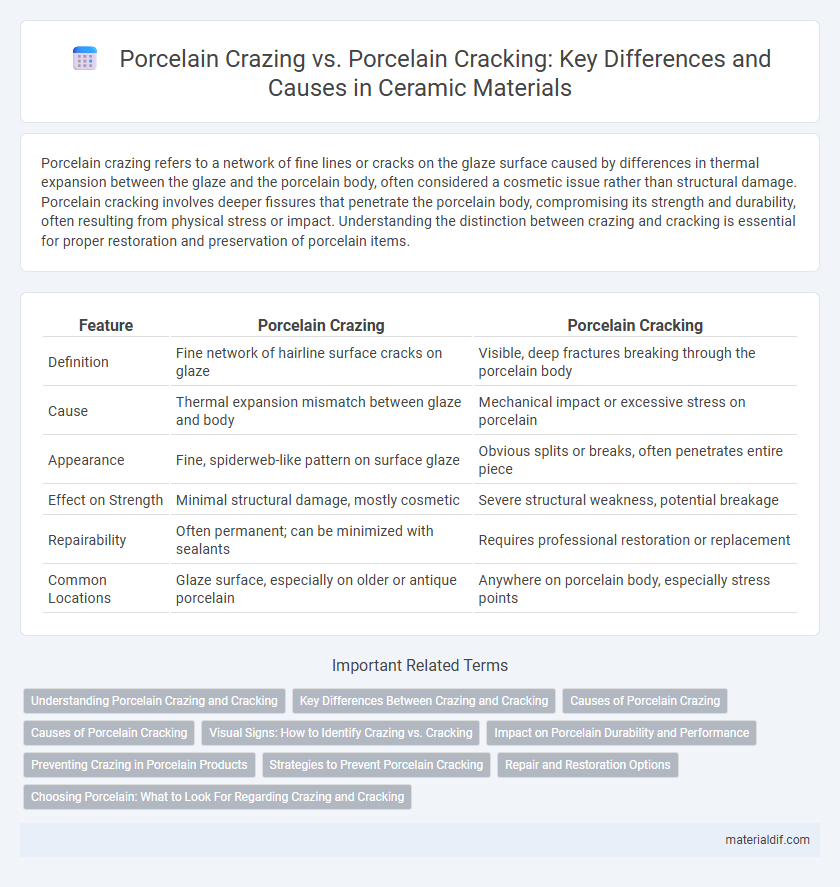Porcelain crazing refers to a network of fine lines or cracks on the glaze surface caused by differences in thermal expansion between the glaze and the porcelain body, often considered a cosmetic issue rather than structural damage. Porcelain cracking involves deeper fissures that penetrate the porcelain body, compromising its strength and durability, often resulting from physical stress or impact. Understanding the distinction between crazing and cracking is essential for proper restoration and preservation of porcelain items.
Table of Comparison
| Feature | Porcelain Crazing | Porcelain Cracking |
|---|---|---|
| Definition | Fine network of hairline surface cracks on glaze | Visible, deep fractures breaking through the porcelain body |
| Cause | Thermal expansion mismatch between glaze and body | Mechanical impact or excessive stress on porcelain |
| Appearance | Fine, spiderweb-like pattern on surface glaze | Obvious splits or breaks, often penetrates entire piece |
| Effect on Strength | Minimal structural damage, mostly cosmetic | Severe structural weakness, potential breakage |
| Repairability | Often permanent; can be minimized with sealants | Requires professional restoration or replacement |
| Common Locations | Glaze surface, especially on older or antique porcelain | Anywhere on porcelain body, especially stress points |
Understanding Porcelain Crazing and Cracking
Porcelain crazing refers to a network of fine, hairline cracks on the glaze surface caused by differences in thermal expansion between the glaze and the porcelain body, often resulting from rapid temperature changes or improper firing. Porcelain cracking is a deeper, more severe break that penetrates through the body or glaze, usually due to mechanical impact, stress, or structural weakness. Understanding the distinction between crazing and cracking is crucial for proper restoration, conservation, and evaluating the durability of porcelain artifacts.
Key Differences Between Crazing and Cracking
Porcelain crazing refers to the network of fine, hairline cracks on the surface glaze caused by uneven cooling or shrinkage, while porcelain cracking involves deeper fractures that penetrate through the glaze and body, compromising structural integrity. Crazing affects the aesthetic appearance and may lead to glaze discoloration, whereas cracking usually results in weakened porcelain and potential breakage. The key difference lies in crazing being a surface phenomenon primarily impacting glaze durability, whereas cracking signifies physical damage requiring repair or replacement.
Causes of Porcelain Crazing
Porcelain crazing occurs when fine, network-like cracks form on the surface due to stress from glaze and body expansion rate mismatches during cooling. This phenomenon is primarily caused by rapid temperature changes or improper glaze formulation that induces tensile stress. Unlike porcelain cracking, crazing does not penetrate deeply and is mostly a surface cosmetic issue rather than structural damage.
Causes of Porcelain Cracking
Porcelain cracking occurs primarily due to thermal stress, improper firing temperatures, or structural weaknesses in the clay body, resulting in visible fractures that compromise the integrity of the piece. Unlike crazing, which involves fine, network-like surface cracks caused by glaze contraction, porcelain cracking penetrates deeper into the ceramic material and is often accompanied by a distinct breakage pattern. Environmental factors, such as rapid cooling or mechanical impact, exacerbate the likelihood of porcelain cracking during manufacturing or usage.
Visual Signs: How to Identify Crazing vs. Cracking
Porcelain crazing appears as a network of fine, hairline surface cracks forming a delicate web-like pattern without breaking the porcelain's structural integrity, often visible under close inspection. Porcelain cracking shows deeper, more pronounced fractures that penetrate through the glaze and ceramic body, potentially compromising the item's strength and causing breakage. Visual identification hinges on noticing whether the lines are superficial and numerous (crazing) or fewer, larger, and invasive (cracking).
Impact on Porcelain Durability and Performance
Porcelain crazing refers to a network of fine surface cracks caused by thermal expansion differences in the glaze and body, which primarily affects the aesthetic quality but may eventually compromise durability by allowing moisture penetration. Porcelain cracking involves deeper fractures or breaks that significantly reduce structural integrity and performance, leading to potential failure under stress or load. Understanding the distinction between crazing and cracking is crucial for assessing porcelain's lifespan and suitability for functional applications.
Preventing Crazing in Porcelain Products
Preventing crazing in porcelain products involves controlling the cooling process and maintaining proper glaze fit to avoid stress between the glaze and the ceramic body. Using compatible materials and ensuring correct firing temperatures reduce the risk of fine surface cracks known as crazing, which differ from deeper, structural cracks found in porcelain cracking. Consistent quality control during manufacturing and avoiding sudden temperature changes during use help maintain the integrity and appearance of porcelain items.
Strategies to Prevent Porcelain Cracking
Porcelain cracking occurs when the material undergoes thermal or mechanical stress beyond its tolerance, whereas crazing involves a network of fine surface cracks due to glaze shrinkage. Strategies to prevent porcelain cracking include controlling firing temperatures precisely to avoid thermal shock, using compatible glaze formulations to minimize tension, and reinforcing porcelain with materials like alumina to enhance durability. Proper handling, slow cooling processes, and avoiding sudden temperature changes during use also reduce the risk of structural cracks in porcelain products.
Repair and Restoration Options
Porcelain crazing appears as a network of fine surface cracks caused by glaze shrinkage, while porcelain cracking involves deeper fractures compromising structural integrity. Repair options for crazing typically include professional cleaning and specialized sealants to prevent further damage and moisture infiltration. Restoration of cracked porcelain may require expert adhesive bonding techniques or partial replacement to restore functionality and aesthetic value.
Choosing Porcelain: What to Look For Regarding Crazing and Cracking
When choosing porcelain, it is essential to differentiate between crazing and cracking to ensure durability and aesthetic appeal. Crazing refers to fine, network-like surface lines caused by glaze shrinkage, often harmless but sometimes affecting appearance, while cracking involves deeper structural fractures compromising the porcelain's strength. Opt for high-quality porcelain with minimal crazing patterns and no visible cracks to guarantee longevity and maintain its pristine condition.
Porcelain crazing vs Porcelain cracking Infographic

 materialdif.com
materialdif.com